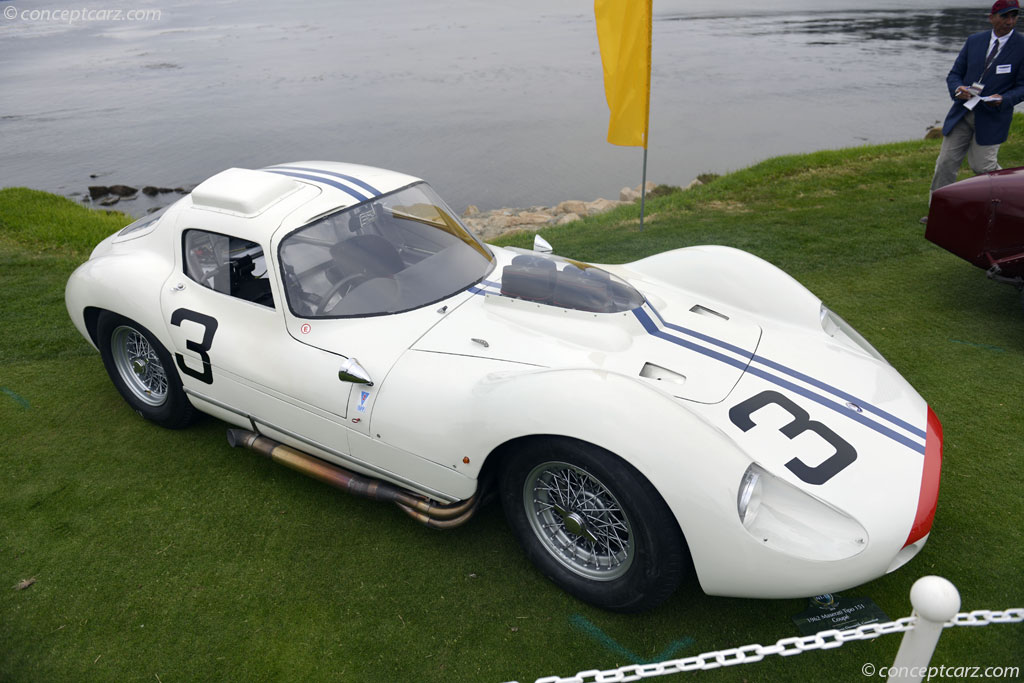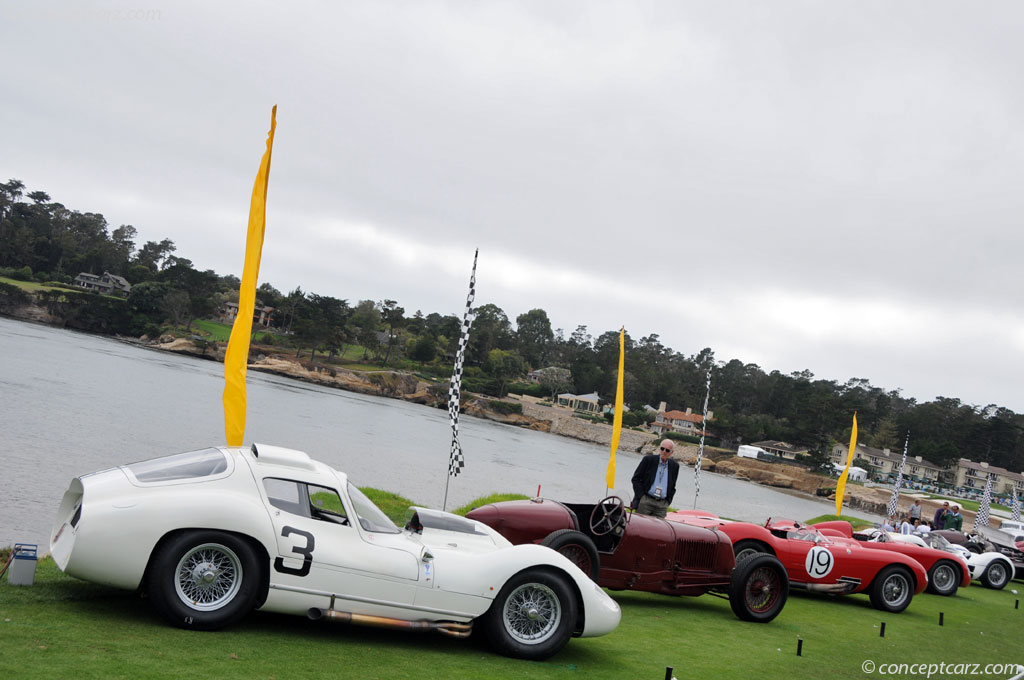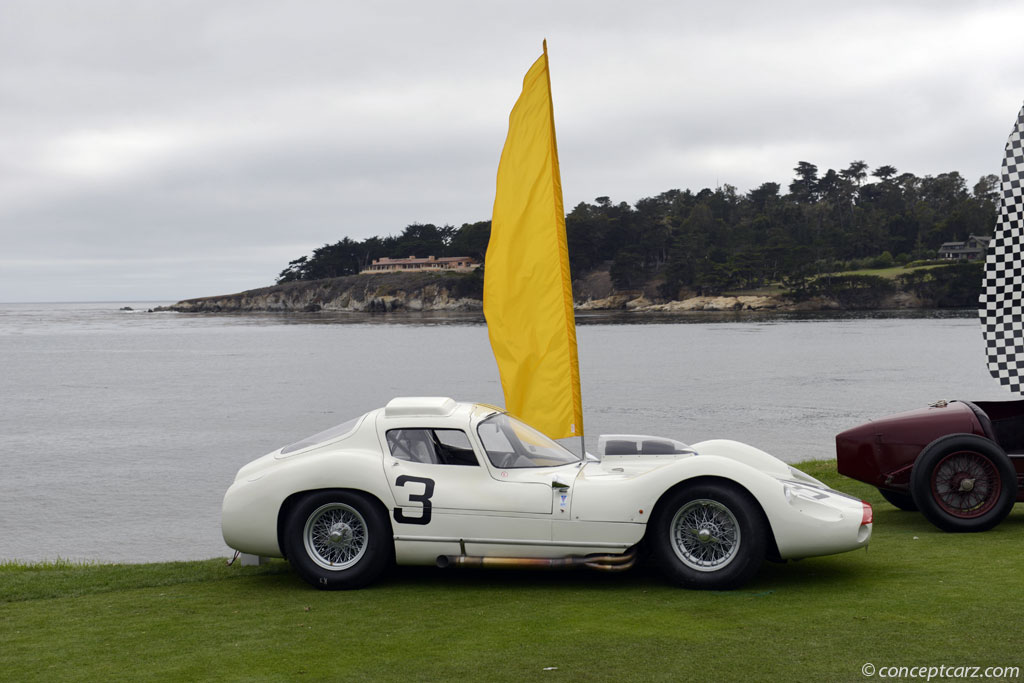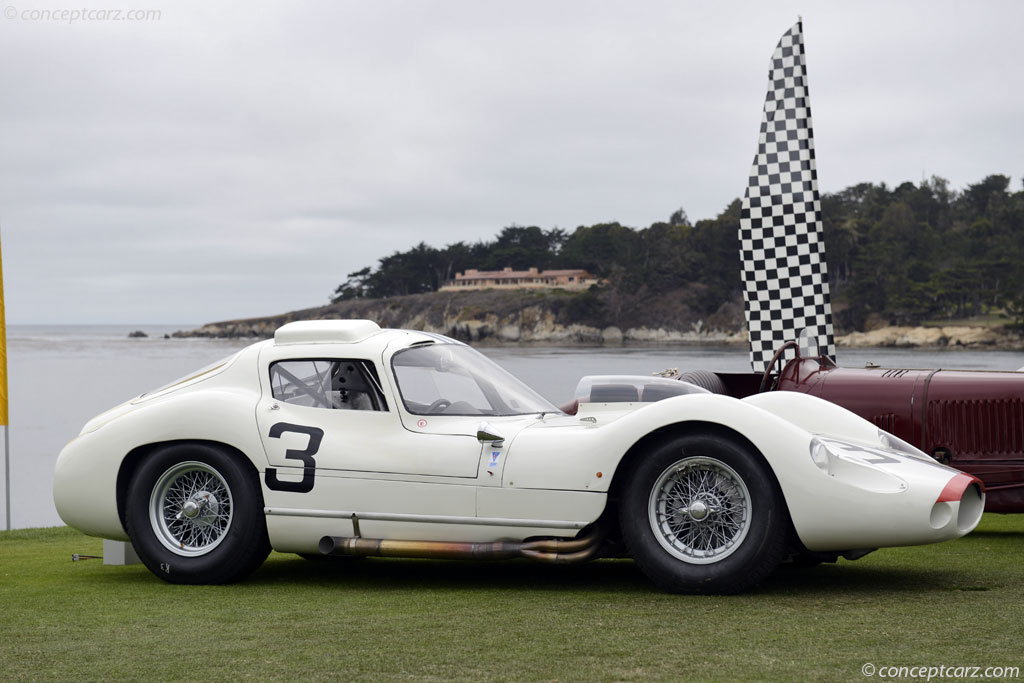At a time when Maserati's financial picture couldn't have looked more bleak, it would be enticed to build what many would end up considering to be one of their finest sportscars ever. It would even be suggested it could have been one of the greatest of all time if Maserati had had the money to develop it. Unfortunately, the Maserati Tipo 151 forever lives in relative obscurity when it truly deserves to be remembered as much more.
Coupe
Chassis #: 151.006
View info and history
Auction entries : 1It is often remarked that for a race team to win a championship or one of the big races it takes all of the necessary elements coming together, working to perfection. Maserati's biggest importers, Briggs Cunningham in the United States and Johnny Simone in France, were convinced Maserati had all of the necessary components just lying around its factory, they just needed to be identified and put together into a winning formula, and the 1962 rule changes imposed by the FIA offered the opportunity needed to help Maserati achieve victory at Le Mans.Heading into the 1962 season the FIA would decide to ban the more complex and costly open top sportscar prototypes. The FIA, in turn, wanted to return to more of a GT class that would have a minimum production for homologation reasons. The ACO, in turn, would be bothered by this decision. By the early 1960s, crowds were becoming used to, and were intrigued by, the prototypes produced in very small numbers by major manufacturers. In addition, the ACO was concerned the apparent step backward would cause many of the major manufacturers to lose interest and pull out. The ACO feared the move to take away the prototypes would hurt interest in its biggest race, the 24 Hours of Le Mans. Therefore, the ACO would fire back. They would create a class that would be known as the GT Prototype class. This would allow prototypes that could go into mass-production in the future to race, but without earning any points toward the World Championship. To complete the creation of the class, the ACO would increase the maximum engine capacity from the 3-liter limit to 4-liters for the GT Prototypes. And for Cunningham and Simone, this appeared to be the perfect opportunity for Maserati, and themselves.
Coupe
Chassis #: 151.006
View info and history
Auction entries : 1Cunningham and Simone believed Maserati had its perfect opportunity. The Modena-based manufacturer had garnered some earlier sportscar success with its radical birdcage designs, but by 1962 had no suitable production car rolling off the production line to be used in the GT ranks. Being Maseratis two largest dealers, Cunningham and Simone believed the ACO/FIA new GT Prototype class would be the perfect opportunity for Maserati to take from the components it already had and make a low volume, custom-built prototype for use at Le Mans. Of course, Cunningham and Simone believed this could work and wanted it to work as they had Maseratis in their showrooms they needed to sell, and the intrigue and a possible success of a Maserati prototype at Le Mans would certainly help to do just that.Given time, money and available resources, Maserati, who would agree to the plan to build a GT Prototype only when Cunningham and Simone assured the company that it would be their customers that would pay the bill for the development of the new prototype, would return to a much simpler and conventional chassis construction. Instead of using their famed 'Birdcage' design, Giulio Alfieri and his team would use a traditional frame utilizing both round and oval tubes in a trellis layout. The reasoning behind this was rather straightforward. Using a more traditional tube chassis offered simplicity, which is important for a long endurance race like Le Mans, but it also offered a beefier frame that could handle the punishment a whole lot better.The chassis layout and construction finished, attention would turn to the car's suspension. The front suspension would be comprised of an independent arrangement using coil springs and Koni telescopic shock absorbers. And while the front suspension would follow the traditional and simplistic mindset that would go into every other aspect of the car, the rear suspension would be anything but conventional and traditional. The rear suspension would utilize an articulated De Dion axle with coil springs and Koni telescopic shock absorbers. The rear suspension would make use of extra struts on both sides and allowed for much more lateral movement. Braking power for the car would come from Girling disc brakes on all four wheels.
Coupe
Chassis #: 151.006
View info and history
Auction entries : 1With braking and handling being dealt with, Maserati then turned to power. Cunningham and Simone were convinced Maserati could build a GT Prototype from components Maserati already had in existence and this would be true of the Tipo 151, as it would become known, and its engine. Maserati had been producing a 450S engine that would be in such Maserati models as its 5000GT. Unfortunately, the engine was of larger displacement than the 4-liter limit. But Alfieri knew the 90 degree V8 was the way to go and he would have the engine's displacement reduced to under 4.0-liters. Aided by four Weber 45 carburetors and a twin spark ignition, the engine could produce around 360 bhp at around 7,000 rpm. All of this power would be delivered to the wheels from the driver's cockpit via a 5-speed Colotti gearbox.The majority of the car would be of traditional, conventional design. However, the body that would be placed on top of the conventional chassis would look anything but conventional. Suggested that it draws its looks from Frank Costin's Zagato body, the Tipo 151/1 would sport a long and low nose with a large oval-shaped radiator inlet out on the point of the nose. The low profile of the nose cowling created the need for beautifully rounded fenders that rose and then fell, blending seamlessly into the door and rear fenders. One of the most striking aspects to the design of the Tipo 151/1 would be its Kamm-style rear tail that covered the 160-liter long-range fuel tank.Just three cars would be produced. Simone, and his Maserati France team, would receive one while Briggs Cunningham would receive the other two. All three would be present at the 1962 24 Hours of Le Mans.
Coupe
Chassis #: 151.006
View info and history
Auction entries : 1The cars had been finished not long before the famous French endurance race, but they would immediately be fast. In fact, only a couple of the Ferraris would be faster in the final practice sessions. Then, in the race, all three would be running in the top five, a couple would even lead for short periods of time. However, suspension failure, mechanical problems and a roll on the track would cause the Maserati threat to come to an end.After Le Mans, Cunningham would take his two Maseratis back to the United States. Simone would send his car, 151.002, back to the Maserati factory in Modena for some updates and some changes.It had been Simone's Tipo 151/1 that suffered suspension failure during the 1962 Le Mans. Therefore, he would send the car back to Modena to have the suspension looked after. Maserati would refine and revise the De Dion suspension and would even be able to reduce the car's overall weight down to under 900kg. Additionally, the rules governing the 4-liter displacement would be lifted heading into the 1963 season. Therefore, the crew at Maserati would remove the 3.9-liter engine and would put its normal 4.94-liter, Lucas fuel injected engine into the car. This would cause the power to jump up in the car from 360 bhp to an impressive 430 bhp.
Coupe
Chassis #: 151.006
View info and history
Auction entries : 1The new engine would also lead Alfieri to redesign the upper lines of the profile of the car's nose as well. Instead of flat line across and the air inlet protruding out of the top of the cowling, a rounded hood would be installed on the revised car. The air inlet, instead of coming out of the top, would be turned into an air scoop with the opening being between the new rounded hood and the original line of the nose.These changes would lead to Simone's Tipo 151/1 being renumbered to Tipo 151/2. Adorned with an overall red livery sporting blue and white stripes signifying the Italian-French partnership, the 002 chassis would make its way to Le Mans for the 1963 running of the French classic.Beefed up with the 5.0-liter V8, the Tipo 151/2 entered by Johnny Simone's Maserati France team would be the fastest car down the straights during practice and that would be something Andre Simon would greatly rely upon at the start of the race when the door stuck shut. Falling outside of the top ten when he finally got started, Simon would use the power of the Maserati to get within reach of the leader by the end of the Mulsanne. By the end of the lap, and for the next four hours, Simon would lead the way in the updated Tipo 151. Unfortunately, after four hours, the transmission would fail on the car and the race would be over.
Coupe
Chassis #: 151.006
View info and history
Auction entries : 1Though the 1963 24 Hours of Le Mans would come to an end without a race finish, it would not be the end to Maserati Tipo 151/2 #002. Once again, the car would return to the factory to undergo revision. At the factory, the body design would be changed to a striking Pierre Drogo design with a flat roof that extended into a high tail.In this new form, the now called Tipo 151/3, would reach an impressive 196 mph down the Mulsanne but would still fail to finish the race after electrical problems brought the campaign to an end. Incidentally, Andre Simon would be the car's driver again in 1964.Unfortunately, at the 1965 Le Mans test, Lloyd 'Lucky' Casner would end up not being so lucky as he would lose control of the Tipo 151 on a wet Le Mans circuit. The car would crash heavily causing a lot of damage, but that would be minimal compared to the fact Casner would lose his life as a result of the crash.
Coupe
Chassis #: 151.006
View info and history
Auction entries : 1The extensive damage caused to 151/3 would cause the car to be scrapped by the factory. The crash would also effectively cause the whole Tipo 151 program to be scrapped by Maserati.As it stands today, only one of the three Tipo 151s exists in original condition. However, a replica of the Tipo 151/3 had been constructed for German collector Peter Kaus.Maurice Trintignant, Andre Simon's co-driver in the 1964 24 Hours of Le Mans, would say about the Tipo 151, 'If it had been properly developed, the 151 could have had exceptional results. Maserati was motivated—there simply wasn't any money to work with.' 
Coupe
Chassis #: 151.006
View info and history
Auction entries : 1In 1963 Le Mans, Simon would prove to everyone that the Maserati Tipo 151 had the potential of being one of the great sportscars in Le Mans history. However, like the whole of Simon's racing career, there would be just one or two necessary elements that just wouldn't come together on the Maserati. As a result, the car barely lives on in memory, instead of being one of the most unforgettable. Therefore, in many ways, the Maserati Tipo 151 would be the perfect car in which Simon would end his racing career. Both showed tremendous speed and promise, but both would lack just those one or two elements that would make them truly great.Sources:
'Maserati Tipo 151', (http://www.maseraticlub.co.uk/trident29.htm). Maserati Club. http://www.maseraticlub.co.uk/trident29.htm. Retrieved 26 July 2012.'Le Mans 24 Hours', (http://www.racingsportscars.com/photo/Le_Mans-1963-06-16.html?sort=Results). Racing Sports Cars. http://www.racingsportscars.com/photo/Le_Mans-1963-06-16.html?sort=Results. Retrieved 26 July 2012.
Coupe
Chassis #: 151.006
View info and history
Auction entries : 1'1965 Maserati Tipo 151 News, Pictures, and Information', (http://www.conceptcarz.com/vehicle/z15698/Maserati-Tipo-151.aspx). Conceptcarz.com: From Concept to Production. http://www.conceptcarz.com/vehicle/z15698/Maserati-Tipo-151.aspx. Retrieved 26 July 2012.'Maserati Tipo 151', (http://www.motorsportsalmanac.com/mastuff/articles/RN_020413.pdf). Motorsportsalmanac.com. http://www.motorsportsalmanac.com/mastuff/articles/RN_020413.pdf. Retrieved 26 July 2012.'1964 Maserati Tipo 151/3', (http://www.supercars.net/cars/2818.html). Supercars.net. http://www.supercars.net/cars/2818.html. Retrieved 26 July 2012.
Coupe
Chassis #: 151.006
View info and history
Auction entries : 1'Maserati Tipo 151', (http://www.ultimatecarpage.com/car/982/Maserati-Tipo-151.html). Ultimatecarpage.com: Powered by Knowledge, Driven by Passion. http://www.ultimatecarpage.com/car/982/Maserati-Tipo-151.html. Retrieved 26 July 2012.
By Jeremy McMullen

Coupe
Chassis #: 151.006
View info and history
Auction entries : 1

Coupe
Chassis #: 151.006
View info and history
Auction entries : 1

Coupe
Chassis #: 151.006
View info and history
Auction entries : 1

Coupe
Chassis #: 151.006
View info and history
Auction entries : 1

Coupe
Chassis #: 151.006
View info and history
Auction entries : 1

Coupe
Chassis #: 151.006
View info and history
Auction entries : 1

Coupe
Chassis #: 151.006
View info and history
Auction entries : 1

Coupe
Chassis #: 151.006
View info and history
Auction entries : 1
'Maserati Tipo 151', (http://www.maseraticlub.co.uk/trident29.htm). Maserati Club. http://www.maseraticlub.co.uk/trident29.htm. Retrieved 26 July 2012.'Le Mans 24 Hours', (http://www.racingsportscars.com/photo/Le_Mans-1963-06-16.html?sort=Results). Racing Sports Cars. http://www.racingsportscars.com/photo/Le_Mans-1963-06-16.html?sort=Results. Retrieved 26 July 2012.

Coupe
Chassis #: 151.006
View info and history
Auction entries : 1

Coupe
Chassis #: 151.006
View info and history
Auction entries : 1
By Jeremy McMullen
1962 Maserati Tipo 151 Vehicle Profiles
Recent Vehicle Additions
Related Automotive News
Aston Martin Works marks 50 years of V8 greatness
The heritage home of the marque, Aston Martin Works, is celebrating the golden jubilee of one of its greatest bloodlines – the Aston Martin V8
1972 saw the arrival of the restyled AM V8, which went on to become a signature look for the firms spor...

Aston Martin Legends Join Concours Of Elegance
Five Aston Martin legends have joined the Concours of Elegance line-up, charting the brands evolution into British performance car icon
A 1932 class-winning Le Mans Lightweight is joined by fabled DB24 and DB5 models and the prototype that spawne...

Maserati Tipo 60, Debut And Victory At Rouen On 12 July 1959
Modena, 12 July 2019 – On 12 July 1959, the Maserati Tipo 60 Birdcage, with the 30 year old Stirling Moss at the wheel, made its race debut in the Sport category at Rouen. The Tipo 60 recorded its first win, defeating two Lotus 15 cars and getting...

Derek Hill to Drive Rare Maserati Tipo 151 in Rolex Monterey Motorsports Reunion
MONTEREY, Calif., June 23, 2014 — American race driver Derek Hill, son of World Champion Phil Hill, will strap himself behind the wheel of the lone surviving Maserati Tipo 151, of which only three were ever constructed, to race in the Rolex Monterey...

1963 Andre Simon/Lloyd Casner Maserati Tipo 151/2
At a time when Maseratis financial picture couldnt have looked more bleak, it would be enticed to build what many would end up considering to be one of their finest sportscars ever. It would even be suggested it could have been one of the greatest...
























